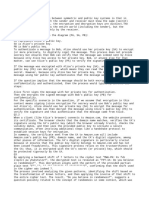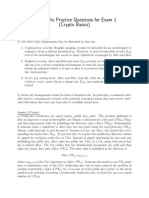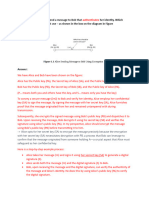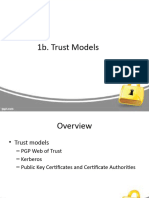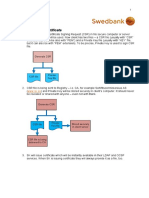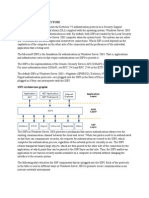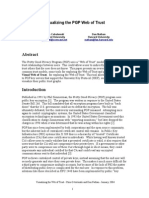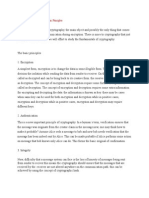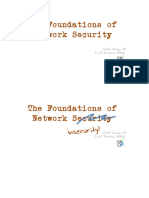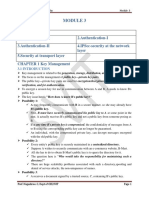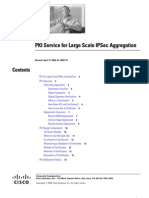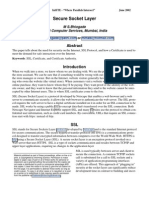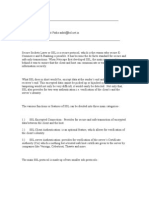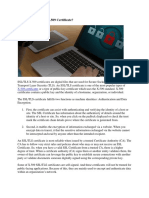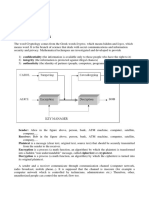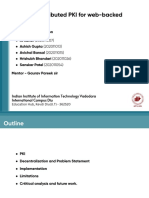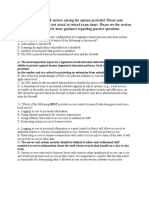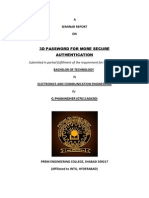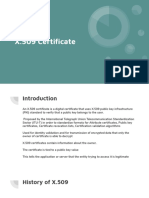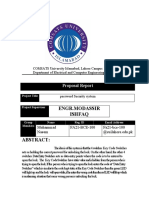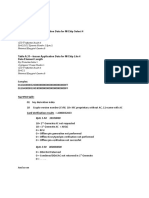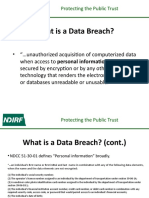IAO201 C
IAO201 C
Uploaded by
phonghoang092003Copyright:
Available Formats
IAO201 C
IAO201 C
Uploaded by
phonghoang092003Original Description:
Original Title
Copyright
Available Formats
Share this document
Did you find this document useful?
Is this content inappropriate?
Copyright:
Available Formats
IAO201 C
IAO201 C
Uploaded by
phonghoang092003Copyright:
Available Formats
Q1
By applying a backward shift of 7 letters to the cipher text "MWA-PH: Kv fvb
ilsplcl pu yhukvtulzz?", the decrypted text is revealed as "FPT-IA: Do you believe
in randomness?". This decryption aligns with the pattern of the provided partial
plain text "F**_**: ** *** ******* ** **********?", confirming that the shift used
in the cipher was indeed 7.
The process involved analyzing the given patterns, identifying the shift based on
the transformation of known letters, and then applying the inverse of that shift to
the entire cipher text. The result, "Do you believe in randomness?", suggests a
question possibly related to the concept of randomness in some context, which was
encrypted using the Caesar cipher technique. This method of decryption is
straightforward for the Caesar cipher, as it relies on a fixed shift of letters in
the alphabet, making it one of the simplest forms of cryptography.
Q2
One important difference between symmetric and public key systems is that in
symmetric key systems both the sender and receiver must know the same (secret)
key.In public key systems, the encryption and decryption keys are distinct.The
encryption key is known by the entire world (including the sender), but the
decryption key is known only by the receiver.
Q3.1
In a public key infrastructure (PKI) setup, each user has a pair of keys: a public
key (PA, PB) which is publicly known and can be shared with anyone, and a private
key (SA, SB) which is kept secret and not shared. When Alice wants to authenticate
her message to Bob, she should use her private key (SA) to encrypt the message.
This process is known as signing. Bob can then use Alice's public key (PA) to
decrypt the message. If the message successfully decrypts with Alice's public key,
it confirms that the message was encrypted with Alice's private key, thus
authenticating her identity.
This method ensures that the message came from Alice because only Alice has access
to her private key. Anyone with access to Alice's public key (which is everyone,
since it's public) can verify that the message was indeed encrypted (signed) using
Alice's private key. If Alice used her public key or Bob's public or private keys,
the message would either not be securely transmitted or would not serve as proof of
Alice's identity to Bob.
Q3.2
When a CA issues a certificate to a website, the purpose of the certificate is to
provide a trusted link between the website and the users who visit it. The
certificate contains the public key of the website (in this case, Amazon.com's
public key) so that visitors (like Alice in the browser) can establish a secure,
encrypted connection using that public key.
The process works as follows:
Amazon sends a certificate signing request (CSR) to the CA. The CSR includes
Amazon's public key and some additional information that identifies the website
(like domain name, company name, etc.).
The CA verifies the identity of Amazon.com and the ownership of the domain.
Once verified, the CA signs the certificate using its own private key (SCA). This
signature allows end-users to verify that the certificate is indeed issued by a
trusted CA.
The signed certificate, now containing Amazon.com's public key and the CA's
signature, is sent back to Amazon.com.
Amazon.com installs the certificate on its server.
When Alice (or any user) visits Amazon.com, her browser requests the certificate.
The browser then uses the CA's public key (PCA), which is already known and trusted
by the browser, to verify the signature on the certificate. If the signature is
valid, it confirms that the certificate is trustworthy and the public key it
contains (Amazon.com's public key) can be used to initiate a secure session. This
public key is then used by Alice's browser to encrypt data that is sent to
Amazon.com, ensuring that sensitive information like passwords or credit card
details are secure.
The certificate does not contain Amazon's private key (SM) because that remains
secret and is never shared. Only the public key, which is meant to be distributed
to users, is included in the certificate.
You might also like
- ECIH Review QuestionsDocument24 pagesECIH Review QuestionsGopinath SNo ratings yet
- Common Errors in BW Related To SSLDocument24 pagesCommon Errors in BW Related To SSLKrishna Chaitanya SunkavalliNo ratings yet
- IAO201 CDocument2 pagesIAO201 Cphonghoang092003No ratings yet
- Cryptography 101 With SSLDocument70 pagesCryptography 101 With SSLpraneetsai.windowsNo ratings yet
- Answers To Practice Questions For Exam 1 (Crypto Basics) : AB ABDocument2 pagesAnswers To Practice Questions For Exam 1 (Crypto Basics) : AB ABNizam DinNo ratings yet
- SSL / TLS Overview Or:: How I Learned To Stop Worrying and Love The CADocument8 pagesSSL / TLS Overview Or:: How I Learned To Stop Worrying and Love The CAtteggelitNo ratings yet
- Basic KerberosDocument8 pagesBasic KerberosvycentyNo ratings yet
- Câu 1Document22 pagesCâu 1doanviethong123No ratings yet
- Digital SignatureDocument3 pagesDigital SignaturerijoiNo ratings yet
- ABCDocument12 pagesABCanhnvthe171086No ratings yet
- Web SecurityDocument17 pagesWeb Securitykejriwal_itNo ratings yet
- Sunny ClassRoom - Digital Signature ConceptDocument50 pagesSunny ClassRoom - Digital Signature Conceptshikhaxohebkhan100% (1)
- Encryption and Its Application To E-CommerceDocument13 pagesEncryption and Its Application To E-CommerceAk KumarNo ratings yet
- Secure Socket Layer: Barnali Gupta BanikDocument35 pagesSecure Socket Layer: Barnali Gupta BanikbarnaliguptabanikNo ratings yet
- Chapter 18: Fundamentals of The Public Key InfrastructureDocument21 pagesChapter 18: Fundamentals of The Public Key Infrastructureflorinn81No ratings yet
- CH 10 ExtractDocument22 pagesCH 10 ExtractMuhammad asafNo ratings yet
- Setup A Taskwarrior ServerDocument14 pagesSetup A Taskwarrior ServerpolettixNo ratings yet
- Iao201 PeDocument1 pageIao201 Pehuydqhe171653No ratings yet
- Trust ModelsDocument22 pagesTrust ModelsEzra muchui murungiNo ratings yet
- Generate SSL Certificates With OpenSSL For SAP SystemsDocument60 pagesGenerate SSL Certificates With OpenSSL For SAP SystemsAdaikalam Alexander RayappaNo ratings yet
- SSL/TLS Mutual Authentication PrimerDocument3 pagesSSL/TLS Mutual Authentication PrimersaidkgNo ratings yet
- Lifecycle of A Certificate: Generate CSRDocument6 pagesLifecycle of A Certificate: Generate CSRreanve100% (1)
- 5 SecurityDocument30 pages5 SecurityPravin RaiNo ratings yet
- SSL/TLS: 1. The Client Sends The Server The Client's SSL Version Number, Cipher SettingsDocument2 pagesSSL/TLS: 1. The Client Sends The Server The Client's SSL Version Number, Cipher SettingsGaurav SharmaNo ratings yet
- Understanding Digital Certificates and Wireless Transport Layer Security (WTLS)Document6 pagesUnderstanding Digital Certificates and Wireless Transport Layer Security (WTLS)Fawad Ali Sher KhanNo ratings yet
- PKI Based Work Flow - ReportDocument8 pagesPKI Based Work Flow - ReportSparsh BajoriaNo ratings yet
- Kerberos SSP ArchitectureDocument86 pagesKerberos SSP ArchitectureishuminiNo ratings yet
- ASA Certs and TrustpointsDocument7 pagesASA Certs and TrustpointsajaymctsNo ratings yet
- OWASP Testing Guide V4editadoDocument157 pagesOWASP Testing Guide V4editadoJeferson PonceNo ratings yet
- Goppa McelieceDocument41 pagesGoppa McelieceleoverobrNo ratings yet
- Grid Computing 7700: Fall 2005 Lecture 16: Grid SecurityDocument32 pagesGrid Computing 7700: Fall 2005 Lecture 16: Grid SecurityJaswanth RoyalNo ratings yet
- Signing Mime Ietf Standards Track RSA Data Security Ietf PKCS#7 Cryptographic Message SyntaxDocument11 pagesSigning Mime Ietf Standards Track RSA Data Security Ietf PKCS#7 Cryptographic Message SyntaxMohabath MohaunixNo ratings yet
- IAO201 CDocument5 pagesIAO201 Cphonghoang092003No ratings yet
- Nathande-Ccbelenski Paper PDFDocument12 pagesNathande-Ccbelenski Paper PDFmaltejkNo ratings yet
- Technology Overview: Introduction To Digital CertificateDocument10 pagesTechnology Overview: Introduction To Digital CertificateG.m. RajaNo ratings yet
- Server Authentication During SSL HandshakeDocument11 pagesServer Authentication During SSL HandshakenisajamesNo ratings yet
- EAP-TLS - Learning GuideDocument11 pagesEAP-TLS - Learning Guiderayhane.gouissemNo ratings yet
- TunnellingDocument14 pagesTunnellingImad TechieNo ratings yet
- Introduction To Cryptography Basic PrinciplesDocument3 pagesIntroduction To Cryptography Basic PrinciplesReddy SumanthNo ratings yet
- SSL Certificates HOWTODocument4 pagesSSL Certificates HOWTOArjun MuruganNo ratings yet
- 2023 12 19 Security FoundationsDocument105 pages2023 12 19 Security FoundationsTamai Aisea AniseNo ratings yet
- Answer Review Week 4 - Suryadin Akbar - 1113100 PDFDocument4 pagesAnswer Review Week 4 - Suryadin Akbar - 1113100 PDFHonest Syarof Esabella100% (2)
- Application Note 3ADR011240 AC500 V3 - Encryption and Certificates - Introduction and ConfigurationDocument29 pagesApplication Note 3ADR011240 AC500 V3 - Encryption and Certificates - Introduction and ConfigurationMariano CorderoNo ratings yet
- So A Book ExtractDocument7 pagesSo A Book ExtractAvinashYadavNo ratings yet
- SSL Signed Vs Self Signed CertificatesDocument4 pagesSSL Signed Vs Self Signed Certificatespawan_battulaNo ratings yet
- Cyber SecurityDocument33 pagesCyber Securitytammy143012No ratings yet
- Operating A Certificate AuthorityDocument3 pagesOperating A Certificate AuthorityVishal Shinde100% (1)
- Chapters 1.key Management 2.Authentication-I 3.Authentication-Ii 4.Ipsec-Security at The Network Layer 5.security at Transport LayerDocument56 pagesChapters 1.key Management 2.Authentication-I 3.Authentication-Ii 4.Ipsec-Security at The Network Layer 5.security at Transport LayerRavish ShankarNo ratings yet
- PKI SecurityDocument64 pagesPKI SecurityVivien Di100% (1)
- How Secure Are Your Channels?: by Morag HughsonDocument8 pagesHow Secure Are Your Channels?: by Morag HughsonkarthickmsitNo ratings yet
- Secure Socket Layer: M S.Bhiogade Patni Computer Services, Mumbai, IndiaDocument6 pagesSecure Socket Layer: M S.Bhiogade Patni Computer Services, Mumbai, Indiadidiey87No ratings yet
- Secure Socket LayerDocument4 pagesSecure Socket LayerAkhilJaanuNo ratings yet
- Tackling SSL Vulnerabilities For Secure Online Transactions: E-GuideDocument13 pagesTackling SSL Vulnerabilities For Secure Online Transactions: E-GuidewormingNo ratings yet
- Chapter 7Document38 pagesChapter 7Zuko100% (1)
- Charu Gupta B.Tech CS 3 Yr Roll No. 0821510020Document27 pagesCharu Gupta B.Tech CS 3 Yr Roll No. 0821510020Charu GuptaNo ratings yet
- Setup Entire PKI Infrastructure and Access Web Server (HTTPD) Via HTTPSDocument39 pagesSetup Entire PKI Infrastructure and Access Web Server (HTTPD) Via HTTPSAlvin ZetoNo ratings yet
- SSL Torn ApartDocument20 pagesSSL Torn Apartapi-3696720No ratings yet
- Jerad Bates - Public Key InfrastructureDocument30 pagesJerad Bates - Public Key Infrastructurevenkatesh VRNo ratings yet
- X509 Certificate - UNICORE - Lecture 2Document2 pagesX509 Certificate - UNICORE - Lecture 2Salum JumaNo ratings yet
- Telnet What Is An SSL & TLS in Details End To End EncryptionDocument48 pagesTelnet What Is An SSL & TLS in Details End To End EncryptionPaul KatemaNo ratings yet
- BlockChain Technology & Blueprint Ultimate Guide: Learn Everything You Need To Know For Beginners & ExperiencedFrom EverandBlockChain Technology & Blueprint Ultimate Guide: Learn Everything You Need To Know For Beginners & ExperiencedNo ratings yet
- Securing .NET Web Services with SSL: How to Protect “Data in Transit” between Client and Remote ServerFrom EverandSecuring .NET Web Services with SSL: How to Protect “Data in Transit” between Client and Remote ServerNo ratings yet
- Grade 10-12 - Week 5Document4 pagesGrade 10-12 - Week 5Oliver C Silvano100% (1)
- Cryptology: 1 Basic ConceptsDocument3 pagesCryptology: 1 Basic ConceptsMikkelsNo ratings yet
- Az 900 Part3Document89 pagesAz 900 Part3gauri shankarNo ratings yet
- CS391 - Design - Project - End - Sem - PresentationDocument20 pagesCS391 - Design - Project - End - Sem - PresentationSanskar PatelNo ratings yet
- Cns 2Document13 pagesCns 2Priti PatilNo ratings yet
- Risk Management Slides قديمDocument106 pagesRisk Management Slides قديمahmadjoe04No ratings yet
- Understanding Cross Site Scripting XSSDocument8 pagesUnderstanding Cross Site Scripting XSSmanojboga150No ratings yet
- Thatthese Questions Are Not Actual or Retired Exam Items. Please See The Section "About This Manual" For More Guidance Regarding Practice QuestionsDocument5 pagesThatthese Questions Are Not Actual or Retired Exam Items. Please See The Section "About This Manual" For More Guidance Regarding Practice QuestionsrushicNo ratings yet
- Datasheet Forcepoint Intrusion Prevention System enDocument4 pagesDatasheet Forcepoint Intrusion Prevention System envuyaniNo ratings yet
- 3d Password For More Secure AuthenticationDocument7 pages3d Password For More Secure AuthenticationRukshana MeeranNo ratings yet
- Presentation by Sachit SarangDocument17 pagesPresentation by Sachit SarangShrida SupunyaNo ratings yet
- COBIT-Process-Mapping-Table Res Eng 0116Document2 pagesCOBIT-Process-Mapping-Table Res Eng 0116sean prendergastNo ratings yet
- How To Setup LDAP For V7 and LaterDocument5 pagesHow To Setup LDAP For V7 and LaterruzhaNo ratings yet
- S N eSET KUYHAADocument2 pagesS N eSET KUYHAAHeppy Dwi YutantoNo ratings yet
- Ch3 Cryptography and Public Key InfrastructureDocument10 pagesCh3 Cryptography and Public Key InfrastructureGetachew ShambelNo ratings yet
- X.509 CertificateDocument15 pagesX.509 CertificateShivani ShahNo ratings yet
- Itgcs UamDocument28 pagesItgcs UamDenise CruzNo ratings yet
- Paasword Security SystemDocument3 pagesPaasword Security SystemNaeem BalochNo ratings yet
- Mas NSEPDocument61 pagesMas NSEPRajeev DayalaniNo ratings yet
- Slide#5-Etika (Hacker Vs Cracker)Document12 pagesSlide#5-Etika (Hacker Vs Cracker)anon_207108945No ratings yet
- Day1 01 E80 IntroducingEndpointSecurityDocument27 pagesDay1 01 E80 IntroducingEndpointSecurityWeis NonidNo ratings yet
- OAuth Pros and ConsDocument12 pagesOAuth Pros and ConsNickleus JimenezNo ratings yet
- Table A.30-Issuer Application Data For M/Chip Select 4 Data Element LengthDocument10 pagesTable A.30-Issuer Application Data For M/Chip Select 4 Data Element LengthPrabin ShresthaNo ratings yet
- Data Breach Presentation - NDIRFDocument29 pagesData Breach Presentation - NDIRFLukman Hakim Dwi SugitoNo ratings yet
- IP SecurityDocument22 pagesIP SecurityBruno BlayNo ratings yet
- Social EngineeringDocument37 pagesSocial EngineeringolegNo ratings yet
- Discussion 1: Seasonal Employees & Cybersecurity: ReferencesDocument1 pageDiscussion 1: Seasonal Employees & Cybersecurity: ReferencesKen CheruiyotNo ratings yet
- ISF Presentation Jan 29 DDDocument40 pagesISF Presentation Jan 29 DDsudeepjmNo ratings yet


